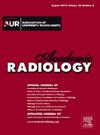Deep Learning for Contrast Enhanced Mammography - A Systematic Review
IF 3.8
2区 医学
Q1 RADIOLOGY, NUCLEAR MEDICINE & MEDICAL IMAGING
引用次数: 0
Abstract
Background/Aim
Contrast-enhanced mammography (CEM) is a relatively novel imaging technique that enables both anatomical and functional breast imaging, with improved diagnostic performance compared to standard 2D mammography. The aim of this study is to systematically review the literature on deep learning (DL) applications for CEM, exploring how these models can further enhance CEM diagnostic potential.
Methods
This systematic review was reported according to the PRISMA guidelines. We searched for studies published up to April 2024. MEDLINE, Scopus and Google Scholar were used as search databases. Two reviewers independently implemented the search strategy. We included all types of original studies published in English that evaluated DL algorithms for automatic analysis of contrast-enhanced mammography CEM images. The quality of the studies was independently evaluated by two reviewers based on the Quality Assessment of Diagnostic Accuracy Studies (QUADAS-2) criteria.
Results
Sixteen relevant studies published between 2018 and 2024 were identified. All but one used convolutional neural network models (CNN) models. All studies evaluated DL algorithms for lesion classification, while six studies also assessed lesion detection or segmentation. Segmentation was performed manually in three studies, both manually and automatically in two studies and automatically in ten studies. For lesion classification on retrospective datasets, CNN models reported varied areas under the curve (AUCs) ranging from 0.53 to 0.99. Models incorporating attention mechanism achieved accuracies of 88.1% and 89.1%. Prospective studies reported AUC values of 0.89 and 0.91. Some studies demonstrated that combining DL models with radiomics featured improved classification. Integrating DL algorithms with radiologists’ assessments enhanced diagnostic performance.
Conclusion
While still at an early research stage, DL can improve CEM diagnostic precision. However, there is a relatively small number of studies evaluating different DL algorithms, and most studies are retrospective. Further prospective testing to assess performance of applications at actual clinical setting is warranted.

对比度增强乳房x线摄影的深度学习-系统综述。
背景/目的:对比增强乳房x线照相术(CEM)是一种相对较新的成像技术,可实现解剖和功能性乳房成像,与标准二维乳房x线照相术相比,具有更高的诊断性能。本研究的目的是系统地回顾深度学习(DL)在CEM中的应用,探讨这些模型如何进一步提高CEM的诊断潜力。方法:本系统综述按照PRISMA指南进行报道。我们检索了截止到2024年4月发表的研究。检索数据库采用MEDLINE、Scopus和谷歌Scholar。两名评论者独立执行搜索策略。我们纳入了所有类型的英文原始研究,这些研究评估了用于对比增强乳房x线造影CEM图像自动分析的DL算法。研究的质量由两位审稿人根据诊断准确性研究质量评估(QUADAS-2)标准独立评估。结果:检索到2018 - 2024年间发表的16篇相关研究。除一家外,其他所有公司都使用了卷积神经网络模型(CNN)模型。所有研究都评估了DL算法的病变分类,而6项研究还评估了病变检测或分割。在三项研究中手工分割,在两项研究中手工和自动分割,在十项研究中自动分割。对于回顾性数据集的病变分类,CNN模型报告的曲线下面积(auc)变化范围为0.53至0.99。引入注意机制的模型准确率分别为88.1%和89.1%。前瞻性研究报告的AUC值为0.89和0.91。一些研究表明,将DL模型与放射组学相结合可以改善分类。将深度学习算法与放射科医生的评估相结合,提高了诊断性能。结论:DL虽处于早期研究阶段,但可提高脑电图的诊断精度。然而,评估不同深度学习算法的研究相对较少,而且大多数研究都是回顾性的。进一步的前瞻性测试,以评估在实际临床设置的应用性能是必要的。
本文章由计算机程序翻译,如有差异,请以英文原文为准。
求助全文
约1分钟内获得全文
求助全文
来源期刊

Academic Radiology
医学-核医学
CiteScore
7.60
自引率
10.40%
发文量
432
审稿时长
18 days
期刊介绍:
Academic Radiology publishes original reports of clinical and laboratory investigations in diagnostic imaging, the diagnostic use of radioactive isotopes, computed tomography, positron emission tomography, magnetic resonance imaging, ultrasound, digital subtraction angiography, image-guided interventions and related techniques. It also includes brief technical reports describing original observations, techniques, and instrumental developments; state-of-the-art reports on clinical issues, new technology and other topics of current medical importance; meta-analyses; scientific studies and opinions on radiologic education; and letters to the Editor.
 求助内容:
求助内容: 应助结果提醒方式:
应助结果提醒方式:


